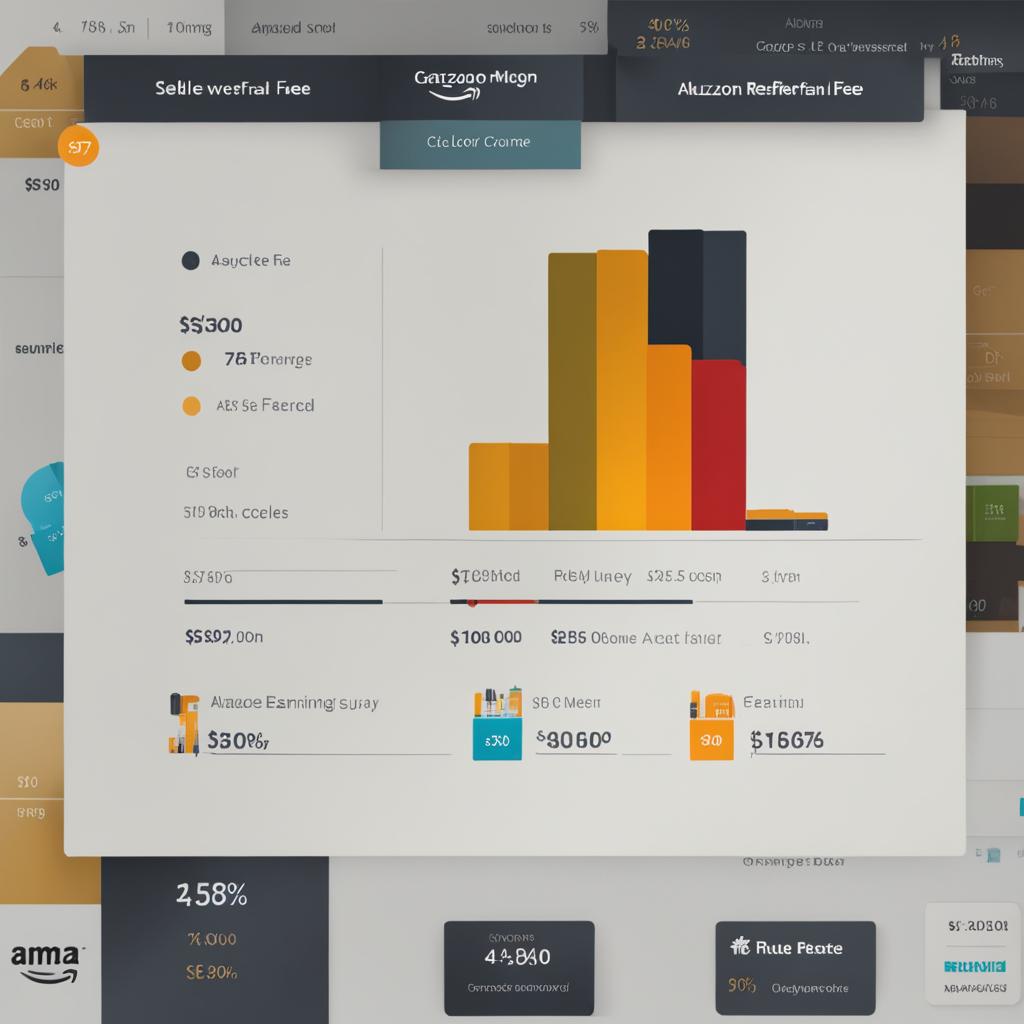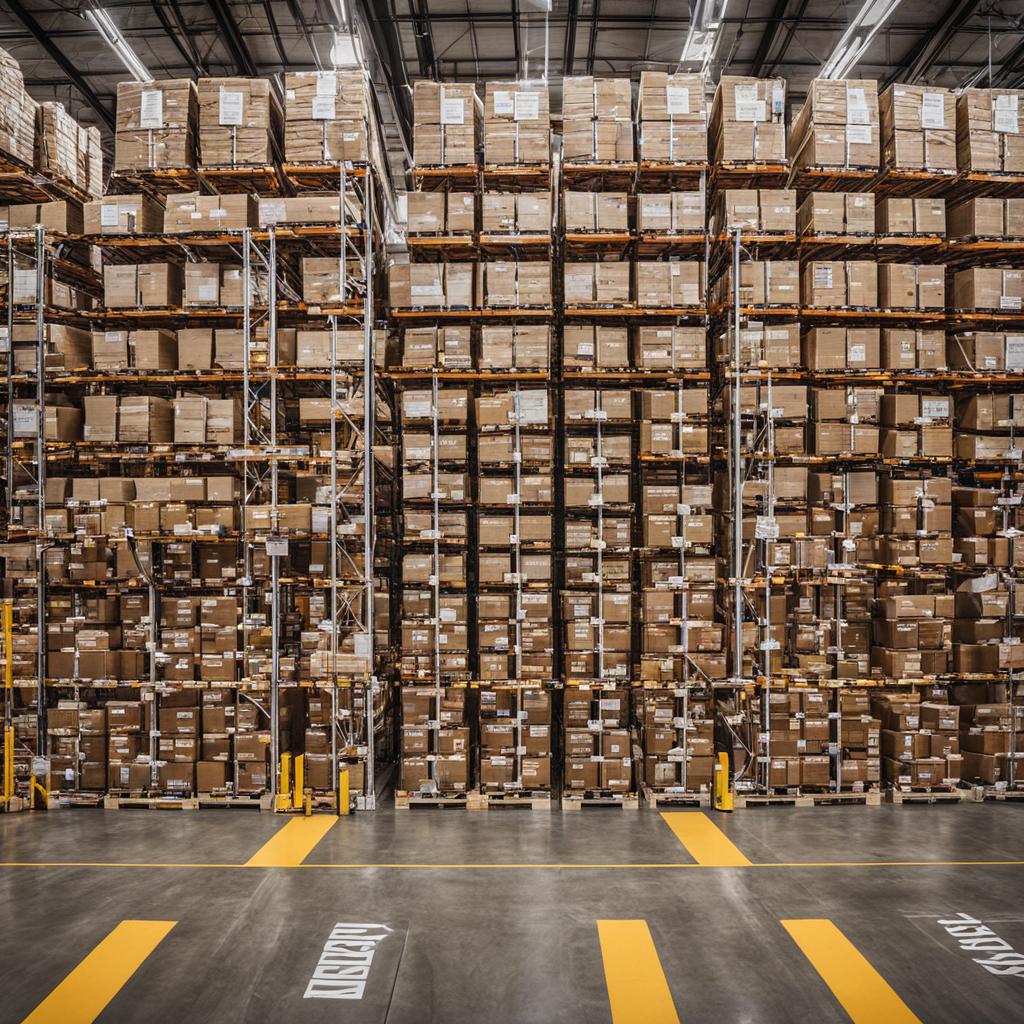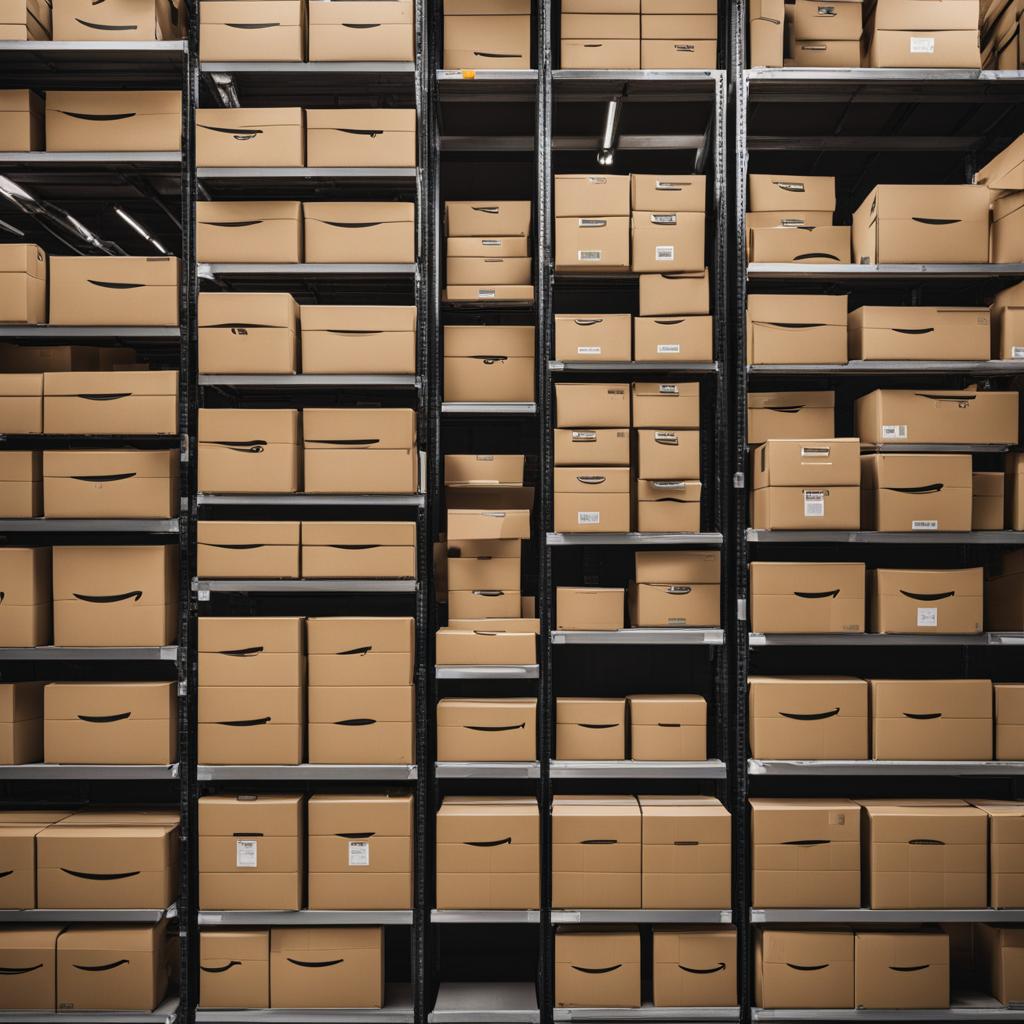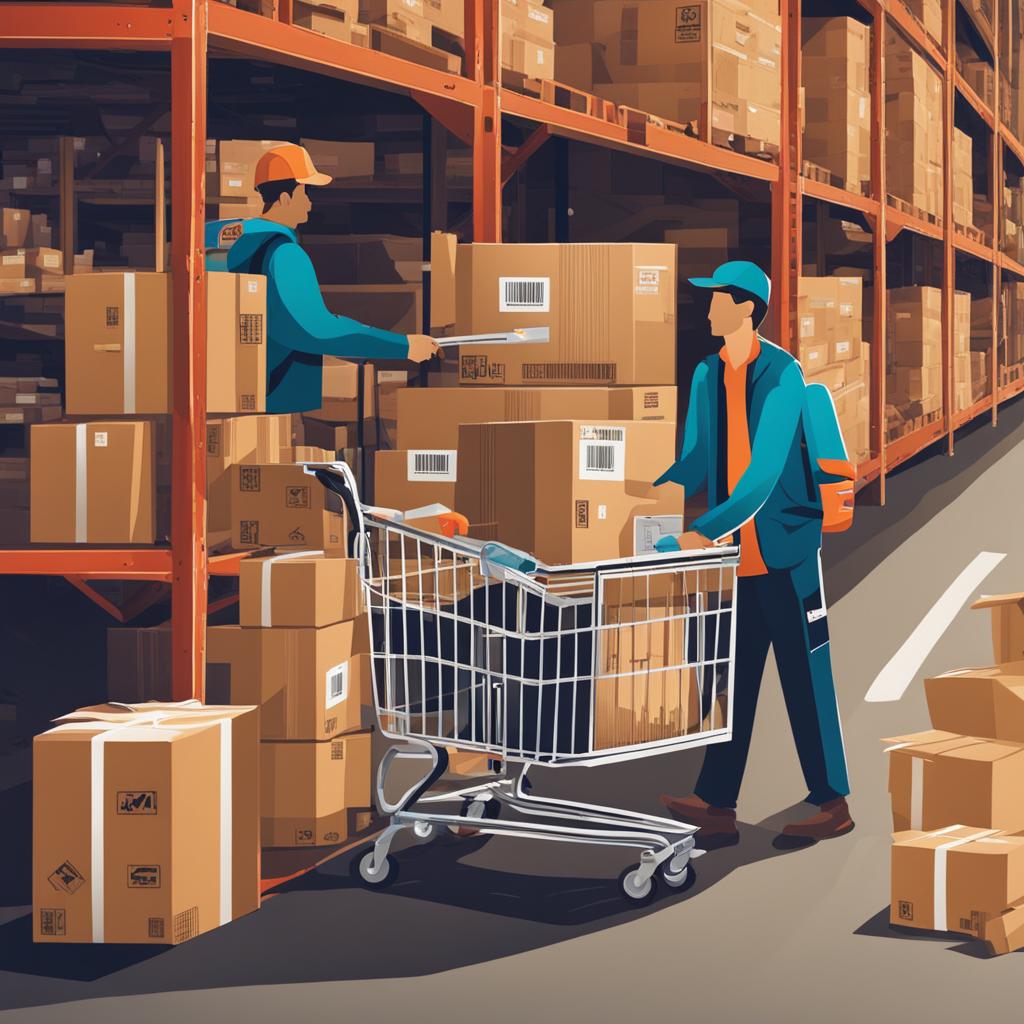Are you considering selling on Amazon to grow your ecommerce business? Look no further than Amazon FBA (Fulfillment by Amazon). As an Amazon seller, you can take advantage of this powerful service that simplifies your order fulfillment process, provides access to a massive customer base, and leverages Amazon’s extensive logistics network. Whether you’re new to online selling or looking to streamline your operations, understanding Amazon FBA is essential for success in the competitive Amazon marketplace.
With Amazon FBA, you can outsource your storage, picking, packing, and shipping tasks to Amazon’s fulfillment centers. This leaves you with more time to focus on product sourcing, marketing, and growing your business. By partnering with Amazon, you tap into their expertise in inventory management and benefit from their seamless integration with the Amazon marketplace. You become an Amazon seller, taking advantage of their trusted brand and millions of daily visitors.
When you join Amazon FBA, you send your products to Amazon’s warehouses. From there, Amazon takes care of storing your inventory and fulfilling your orders. They handle the entire fulfillment process, including customer service and returns. You no longer need to worry about packing boxes, printing shipping labels, or managing inventory levels. Amazon FBA frees up your time and resources, allowing you to focus on expanding your product offerings and scaling your business.
Key Takeaways:
- Amazon FBA (Fulfillment by Amazon) offers a streamlined order fulfillment and shipping service for third-party sellers on Amazon.
- Sellers send their products to Amazon’s fulfillment centers, where Amazon takes care of storage, picking, packing, and shipping.
- Amazon FBA provides access to Amazon’s extensive logistics network and customer base, aiding in the growth and scalability of your ecommerce business.
- In exchange for their services, sellers pay fees for fulfillment, storage, and optional services.
- Understanding and utilizing Amazon FBA can give you a competitive edge in the online marketplace.
Understanding Amazon Seller Fees
As an Amazon seller, it’s crucial to have a clear understanding of the various fees associated with selling on their platform. These fees can significantly impact your profitability and overall success. In this section, we will explore the different types of fees that you may encounter, including referral fees, fulfillment fees, storage fees, removal fees, disposal fees, and refund administration fees.
Referral Fees
Referral fees are a percentage of the product’s selling price that sellers pay to Amazon for each item sold. The exact percentage varies depending on the category of the product. It’s essential to be aware of these fees as they directly impact your revenue.
Fulfillment Fees
Fulfillment fees are charges for utilizing Amazon’s FBA (Fulfillment by Amazon) service to handle the picking, packing, and shipping of your orders. These fees are based on the size and weight of the product being shipped. Properly understanding fulfillment fees is crucial in determining the most cost-effective fulfillment method for your business.
Storage Fees
As an FBA seller, you benefit from the convenience of Amazon’s fulfillment centers for storing your inventory. However, there are monthly storage fees associated with using this service. The fees depend on the physical size and type of the items you are storing. It’s essential to manage your inventory efficiently to avoid accumulating unnecessary storage costs.
Removal and Disposal Fees
If you need to remove or dispose of any inventory stored in Amazon’s fulfillment centers, there are specific fees associated with these actions. Removal fees apply when you request to have your inventory returned to you, and disposal fees occur when you opt to have your inventory disposed of by Amazon.
Refund Administration Fees
When Amazon processes refunds for customers, they charge refund administration fees to sellers. It’s important to factor in these fees when calculating your overall costs and profitability.
To provide you with a clearer understanding of the Amazon seller fees, here is a visual representation:
| FEE TYPE | DESCRIPTION |
|---|---|
| Referral Fees | A percentage of the product’s selling price |
| Fulfillment Fees | Charges for picking, packing, and shipping orders through FBA |
| Storage Fees | Monthly charges for storing inventory in Amazon’s fulfillment centers |
| Removal and Disposal Fees | Fees for removing or disposing of inventory |
| Refund Administration Fees | Fees charged when Amazon processes refunds for customers |
By carefully understanding and managing these fees, you can make informed decisions and optimize your selling strategy on Amazon. Now that we’ve covered the basics of Amazon seller fees, let’s dive deeper into referral fees, their percentages, and minimum fees in the next section.
Amazon Referral Fees
When selling products on Amazon, it’s important to understand the referral fees associated with each item sold. Referral fees are charges that Amazon imposes on sellers for using their platform to sell their products. These fees play a significant role in determining the overall profitability of your business.
The referral fee amount is calculated based on a percentage of the product’s selling price or a minimum fee, whichever is greater. The specific percentage varies depending on the category of the product. For example, the referral fee percentage for electronics may differ from that of home and kitchen products.
It’s crucial to note that referral fees for certain categories are subject to changes over time. To give you an example, starting January 15, 2024, referral fees for apparel products priced below $20 will be reduced. Staying updated with these changes will help you make informed decisions and manage your costs effectively.
As a seller, being aware of the referral fee percentages and minimum fees applicable to your products is essential for accurate pricing and profitability calculations. This knowledge allows you to determine the optimal selling price to cover these fees while maximizing your profit margin.
To provide visual clarity, here’s an image that represents the breakdown of Amazon referral fees:

Understanding and carefully considering the referral fees associated with each sale empowers you to make strategic pricing decisions and ensures that your business operates profitably on the Amazon platform.
Amazon FBA Fulfillment Fees
When using Amazon FBA to fulfill orders, sellers need to be aware of the fulfillment fees charged by Amazon. These fees are determined based on the size and weight of the products being shipped. Different fee structures apply to standard size products, oversize products, and apparel products.
For standard size products, the fulfillment fees range from $3.22 to $4.75 per unit. These fees cover the cost of picking, packing, and shipping the products to customers. Oversize products, on the other hand, have higher fulfillment fees due to their larger dimensions and weight. Oversize fees can range from $9.73 to $179.28 or more, depending on the specific dimensions of the products.
Apparel products have their own pricing structure for fulfillment fees. The fees are based on the weight of the items, as well as any additional packaging or handling requirements. Sellers who sell apparel products through Amazon FBA should review the specific fee structure provided by Amazon to accurately calculate their fulfillment costs.
Below is a table summarizing the fulfillment fees for different product categories:
| Product Category | Fulfillment Fee Range (per unit) |
|---|---|
| Standard Size | $3.22 – $4.75 |
| Oversize | $9.73 – $179.28 or more |
| Apparel | Varies based on weight and requirements |
It’s important for sellers to carefully consider these fulfillment fees when deciding to use Amazon FBA. While FBA offers many benefits, such as streamlined order fulfillment and access to Amazon’s extensive logistics network, the associated fees can impact a seller’s profitability. By understanding these fees and factoring them into their pricing strategy, sellers can make informed decisions and optimize their FBA experience.

Amazon FBA Storage Fees
When using Amazon FBA, it’s important for sellers to understand and factor in the storage fees charged by Amazon. These fees ensure that your inventory is stored safely and readily available for fulfillment. There are two types of storage fees: monthly storage fees and long-term storage fees. Let’s take a closer look at each one.
Monthly Storage Fees
Amazon charges monthly storage fees based on the time of year, physical size of the items, and the type of item. These fees are determined by the volume of space your inventory occupies in Amazon’s fulfillment centers. It’s important to note that the amount of storage space available may vary throughout the year due to seasonal demand. Here’s an overview of the monthly storage fee structure:
| Item Type | Standard-Size | Oversize |
|---|---|---|
| January to September | $0.75 per cubic foot | $0.48 per cubic foot |
| October to December | $2.40 per cubic foot | $1.20 per cubic foot |
It’s essential to monitor your inventory and adjust accordingly to avoid unnecessary storage fees. Proper inventory management and forecasting can help optimize your storage costs and prevent overstocking or understocking of products.
Long-Term Storage Fees
In addition to monthly storage fees, Amazon also charges long-term storage fees for inventory that has been stored for over a year. These fees are applicable to items that have been in Amazon’s fulfillment centers for an extended period. Long-term storage fees can significantly impact your profitability if not managed properly.
“By monitoring your inventory levels and strategically planning your sales and promotions, you can minimize long-term storage fees and keep your inventory fresh.”
It’s crucial for sellers to regularly assess their inventory and make informed decisions about whether to hold or remove items that are incurring long-term storage fees. This proactive approach can help prevent unnecessary expenses and optimize your overall FBA experience.

By understanding and accounting for Amazon FBA storage fees, sellers can effectively manage their costs and make informed decisions about their inventory. Proper inventory management, including monitoring storage space and assessing long-term storage fees, can help optimize profitability and success on the Amazon platform.
Additional Amazon FBA Fees
In addition to referral fees, fulfillment fees, and storage fees, Amazon FBA has various additional fees that sellers may encounter. These additional fees can impact sellers’ overall costs and should be taken into account when calculating profits. Let’s take a closer look at some of these extra fees:
Aged Inventory Surcharge
Amazon charges an aged inventory surcharge for inventory that has been stored for an extended period of time. This fee is designed to incentivize sellers to manage their inventory effectively and avoid overstocking items that may not sell quickly.
Inventory Storage Overage Fee
Sellers are allocated a certain amount of storage space in Amazon’s fulfillment centers. If a seller exceeds their allocated space, they may incur an inventory storage overage fee. It’s important for sellers to regularly review their inventory levels and adjust their storage accordingly to avoid these additional fees.
Inventory Removal Fees and Disposal Fees
When sellers need to remove or dispose of inventory from Amazon’s fulfillment centers, they may be charged inventory removal fees or disposal fees. It’s essential for sellers to carefully consider their inventory management and make informed decisions to minimize the need for removal or disposal, thus reducing these extra charges.
Unplanned Services Fees and Penalty Fees
Sellers are expected to follow Amazon’s guidelines and standards for packaging, labeling, and shipping their products. Failure to comply with these guidelines can result in unplanned services fees and penalty fees. Sellers should familiarize themselves with Amazon’s requirements and ensure that they adhere to them to avoid these additional charges.
Package Prep Fees
If sellers request Amazon to prep and package their products, they may incur package prep fees. These fees apply when sellers require Amazon to perform additional preparation tasks, such as poly bagging or bubble wrapping, to ensure that the products are ready for shipment.
Being aware of these additional Amazon FBA fees is crucial for sellers to accurately calculate their costs and manage their profitability effectively. By understanding and planning for these fees, sellers can optimize their operations and make informed decisions to maximize their success on the platform.

Pros of Using Amazon FBA
There are several advantages to utilizing Amazon FBA for order fulfillment. Let’s explore the pros of this service:
1. Logistics Support and Scalability
With Amazon FBA, sellers can leverage Amazon’s robust logistics infrastructure. From storing inventory to picking, packing, and shipping orders, Amazon handles the entire fulfillment process. This support allows sellers to focus on growing their business and easily scale their operations.
2. Amazon Prime Benefits
Fulfilling orders through Amazon FBA grants sellers access to valuable Amazon Prime benefits. Prime members enjoy free two-day shipping, which can significantly enhance the shopping experience for customers and increase sales potential for sellers.
3. Shipping Rate Discounts
Amazon has negotiated discounted shipping rates with various carriers due to its extensive logistics network. Using FBA allows sellers to leverage these shipping rate discounts, saving on shipping costs and increasing overall profitability.
4. Customer Support
Amazon provides dedicated customer support for FBA sellers, offering assistance with any fulfillment-related inquiries or issues. This support ensures a smooth and seamless experience for both sellers and customers, building trust and enhancing satisfaction.
5. More Storage Space
Amazon’s fulfillment centers offer ample storage space, far exceeding what most businesses can accommodate on their own. This eliminates the need for offsite warehouses and allows sellers to efficiently manage their inventory without worrying about storage limitations.
6. Multi-channel Fulfillment
FBA enables multi-channel fulfillment, allowing sellers to fulfill orders not only from the Amazon marketplace but also from other platforms and channels. This streamlined process simplifies inventory management and expands selling opportunities.
By taking advantage of these pros, sellers can optimize their order fulfillment, enhance customer satisfaction, and drive business growth.
Cons of Using Amazon FBA
While Amazon FBA offers many advantages, it’s important to consider the potential drawbacks before deciding to use this fulfillment service.
1. Cost
One of the main concerns for sellers is the cost associated with using Amazon FBA. There are various fees involved, including referral fees, fulfillment fees, and storage fees. These fees can significantly impact the profitability of the business and should be carefully calculated and considered.
2. Limited Branding
When using Amazon FBA, sellers lose some control over their branding. Amazon uses its own branded packaging for shipping, which means that sellers do not have the opportunity to showcase their own unique brand identity through the packaging.
3. Commingling
Commingling is a practice used by Amazon FBA where the inventory of multiple sellers is mixed together in the fulfillment centers. While this can help streamline the fulfillment process, it also poses a risk to sellers’ brand reputation. If a customer receives a faulty or counterfeit product from another seller, it may reflect poorly on all commingled sellers.
4. More Returns
Amazon has a generous return policy, which can result in more return requests for sellers using FBA. This can lead to additional costs and logistical challenges associated with processing returns and managing inventory.
5. Continual Inventory Management
Using Amazon FBA requires continual inventory management to comply with Amazon’s requirements and avoid additional fees. Sellers need to closely monitor their inventory levels, ensure timely restocking, and manage any excess or aging inventory to prevent incurring storage and long-term storage fees.
Despite these drawbacks, many sellers still find value in using Amazon FBA due to its convenience, access to customers, and other benefits. It ultimately depends on the individual seller’s business needs and goals.
Using Amazon FBA vs. Seller-Fulfilled Prime
When it comes to order fulfillment on Amazon, sellers have two main options: Amazon FBA and Seller-Fulfilled Prime (SFP). Both options have their advantages and considerations, and understanding the differences between them is crucial in making an informed decision for your business.
Amazon FBA (Fulfillment by Amazon) is a service where Amazon handles the entire fulfillment process on your behalf. This means that once you send your products to Amazon’s fulfillment centers, they take care of picking, packing, and shipping the orders to customers. With FBA, you can take advantage of Amazon’s extensive logistics network and benefit from Amazon Prime eligibility, which offers free two-day shipping to Prime members. This can significantly enhance your product’s visibility and appeal to a broad customer base. Additionally, FBA allows you to scale your business efficiently as Amazon handles the fulfillment workload.
On the other hand, Seller-Fulfilled Prime (SFP) enables you to fulfill your orders from your own facilities while still displaying the Prime badge. This option is suitable for sellers who have the capability to meet Amazon’s shipping standards and fulfill Prime orders reliably and on time. While SFP gives you more control over the fulfillment process and allows for branding opportunities, it comes with the added responsibility of managing the entire shipping process, including storage, packaging, and delivery. It’s important to assess your fulfillment capabilities, including inventory management and shipping efficiency, before opting for SFP.
To better understand the differences between FBA and SFP, let’s break them down based on key factors:
Fulfillment Options
| Amazon FBA | Seller-Fulfilled Prime (SFP) | |
|---|---|---|
| Who handles fulfillment? | Amazon | Seller |
| Shipping standards | High | High |
| Storage and packaging | Handled by Amazon | Handled by seller |
| Shipping and delivery | Handled by Amazon | Handled by seller |
| Prime badge eligibility | Yes | Yes |
As shown in the comparison table, Amazon FBA takes care of the entire fulfillment process, including storage, packaging, and shipping. With SFP, the seller is responsible for all aspects of fulfillment, including maintaining shipping standards and meeting Prime eligibility requirements.
Amazon Prime Eligibility
Both FBA and SFP offer the opportunity to display the Prime badge on your listings, allowing you to tap into Amazon’s loyal Prime customer base. However, it’s important to note that to be eligible for Seller-Fulfilled Prime, you must meet Amazon’s strict shipping standards and consistently deliver orders on time.
Shipping Standards
Whether you choose FBA or SFP, maintaining high shipping standards is crucial for a successful selling experience on Amazon. While Amazon FBA handles all aspects of shipping and delivery, SFP requires you to meet the same high standards set by Amazon to ensure fast and reliable delivery to customers.
Ultimately, the choice between Amazon FBA and Seller-Fulfilled Prime depends on your business’s fulfillment capabilities, Prime eligibility requirements, and your preference for control over the fulfillment process. Consider the scalability and ease of using FBA versus the control and branding opportunities provided by Seller-Fulfilled Prime. Weighing the benefits and limitations of each option will help you determine the best fit for your business.
How to Maximize Amazon FBA Sales
To maximize sales through Amazon FBA, I recommend implementing the following strategies:
- Optimize Product Listings: Create keyword-rich titles and descriptions to improve visibility in search results. Use compelling product images to attract customers and enhance the overall shopping experience.
- Competitive Pricing: Conduct market research to determine competitive pricing for your products. Price your items competitively to attract customers and increase sales.
- Utilize Amazon PPC Ads: Take advantage of Amazon’s Pay-Per-Click (PPC) advertising platform to increase the visibility of your products. This can help drive targeted traffic to your listings.
- Encourage Product Reviews: Positive product reviews play a crucial role in building trust with potential customers. Encourage buyers to leave reviews by providing exceptional customer service and following up with personalized feedback requests.
- Effective Inventory Management: Maintain optimal inventory levels to ensure products are always available. This not only helps fulfill customer orders promptly but also avoids storage fees for excess inventory.
By implementing these strategies, sellers can maximize their FBA sales and achieve greater success on the Amazon platform.
Using Amazon FBA the Right Way
When utilizing Amazon FBA, sellers must approach it strategically to achieve optimal results. This involves several key considerations, including effective product selection and sourcing, establishing a strong brand presence, delivering excellent customer service, and staying informed about Amazon’s policies and guidelines.
Product Selection
Choosing the right products is vital for success on Amazon FBA. Sellers should focus on selecting items with high demand and profit potential. Conducting thorough market research and analyzing customer trends can help identify profitable product opportunities. By offering unique, in-demand products, sellers can stand out and attract customers in the competitive Amazon marketplace.
Product Sourcing
Product sourcing plays a crucial role in the success of FBA sellers. It’s essential to find reliable suppliers or manufacturers that can consistently provide high-quality products. Sellers should consider factors such as product cost, quality control, and shipping times when sourcing their products. Establishing strong relationships with suppliers can ensure a steady supply of inventory and help maintain excellent customer service.
Branding
Branding is key to differentiating products and building customer loyalty on Amazon. Sellers should invest in creating a unique brand identity that resonates with their target audience. This includes designing eye-catching packaging, customizing product inserts, and utilizing compelling product images and descriptions. A strong brand presence can help sellers establish trust, attract repeat customers, and increase overall sales.
Customer Service
Providing exceptional customer service is crucial for Amazon FBA sellers. Promptly addressing customer inquiries, resolving issues, and offering hassle-free returns can enhance the overall shopping experience. Building positive relationships with customers through efficient communication and proactive support can lead to positive feedback and reviews, which can further boost sales and reputation.
Staying Informed
Amazon’s policies and guidelines are subject to change, impacting the operation of FBA sellers. It’s essential to stay updated with any policy revisions, fee adjustments, or new requirements introduced by Amazon. Regularly reviewing and adhering to these updates can ensure compliance, prevent penalties, and maintain a healthy business relationship with Amazon.
To succeed with Amazon FBA, sellers must approach it strategically. By carefully selecting profitable products, establishing a strong brand, prioritizing customer service, and staying informed about Amazon’s policies, sellers can effectively utilize FBA to grow their business and achieve long-term success.
| Key Considerations | Benefits |
|---|---|
| Effective product selection | Increased sales and profitability |
| Strategic product sourcing | Reliable inventory supply |
| Strong branding | Enhanced customer recognition and loyalty |
| Excellent customer service | Positive feedback and reviews |
| Staying informed about Amazon’s policies | Compliance and prevention of penalties |
Conclusion
In conclusion, Amazon FBA (Fulfillment by Amazon) offers sellers a comprehensive fulfillment solution that can greatly benefit their e-commerce businesses. By leveraging Amazon’s vast logistics network and extensive customer base, sellers can streamline their operations and reach a wider audience, ultimately maximizing their success.
However, it is crucial for sellers to carefully consider the associated fees and factor them into their overall costs. Amazon FBA comes with various fees, including referral fees, fulfillment fees, and storage fees, among others. It is essential for sellers to have a clear understanding of these fees to accurately calculate their expenses and ensure profitability.
To fully optimize their use of Amazon FBA, sellers should focus on optimizing their product listings with keyword-rich titles and descriptions, high-quality images, and compelling product descriptions. Effective inventory management is also key to avoid storage fees and ensure products are always available for customers. Additionally, providing excellent customer service and promptly addressing customer inquiries and issues can help maintain positive feedback and reviews.
By understanding the fees, optimizing product listings, managing inventory effectively, and providing exceptional customer service, sellers can unlock the full potential of Amazon FBA and experience tremendous growth in their e-commerce businesses.
FAQ
What is Amazon FBA? How does it work, and what are the fees?
Amazon FBA (Fulfillment by Amazon) is a service offered by Amazon that automates order fulfillment and shipping for third-party sellers. Sellers send their products to Amazon’s fulfillment centers, where Amazon stores, picks, packs, and ships the products to customers. Sellers pay fees for fulfillment, storage, and other optional services provided by Amazon.
What are the different types of Amazon seller fees?
Amazon seller fees can be categorized into referral fees, fulfillment fees, storage fees, removal fees, disposal fees, and refund administration fees.
How are referral fees calculated on Amazon?
Referral fees on Amazon are a percentage of the product’s selling price or a minimum fee, whichever is greater. The percentage varies depending on the product category.
How much are Amazon FBA fulfillment fees?
Amazon FBA fulfillment fees depend on the size and weight of the product. There are different fee structures for standard size products, oversize products, and apparel products.
What are Amazon FBA storage fees?
Amazon FBA storage fees are monthly charges for storing inventory in Amazon’s fulfillment centers. There are also long-term storage fees for inventory stored for over a year.
Are there any additional fees for using Amazon FBA?
Yes, there are additional fees such as aged inventory surcharges, inventory storage overage fees, inventory removal fees, disposal fees, unplanned services fees, penalty fees, and package prep fees.
What are the benefits of using Amazon FBA for order fulfillment?
Some benefits of using Amazon FBA include logistics support, scalability, access to Amazon Prime benefits, shipping rate discounts, customer support, and multi-channel fulfillment.
What are the drawbacks of using Amazon FBA?
Drawbacks of using Amazon FBA include the cost associated with the service, limited branding opportunities, commingling of products, potentially more returns, and the need for continual inventory management.
What is the difference between Amazon FBA and Seller-Fulfilled Prime (SFP)?
Amazon FBA is when Amazon fulfills orders on behalf of the seller, while SFP allows the seller to fulfill orders from their own facilities but still display the Prime badge.
How can I maximize sales through Amazon FBA?
To maximize sales through Amazon FBA, optimize your product listings, offer competitive pricing, utilize Amazon PPC ads, encourage positive product reviews, and effectively manage inventory.
How can I use Amazon FBA effectively?
To use Amazon FBA effectively, carefully consider your product selection and sourcing, focus on branding, provide excellent customer service, and stay updated with Amazon’s policies and guidelines.
What is the conclusion about Amazon FBA?
Amazon FBA offers sellers a comprehensive fulfillment solution with various benefits, but it’s essential to consider the associated fees and factors related to branding, commingling, returns, and inventory management.
Our Friends
- https://www.bigcommerce.com/articles/omnichannel-retail/amazon-fba/
- https://www.shipbob.com/blog/amazon-fba-fees/
- https://www.junglescout.com/blog/amazon-fba-fees/
Money posts:
 Where to Find Top Product Tester Jobs (From Home!) (2024)
Where to Find Top Product Tester Jobs (From Home!) (2024)
 Where to Find Top Product Tester Jobs (From Home!) (2024)
Where to Find Top Product Tester Jobs (From Home!) (2024)
 Instacart vs. DoorDash: Which is Best for Drivers in (2024)?
Instacart vs. DoorDash: Which is Best for Drivers in (2024)?
 The 19 Best Freelance Websites in (2024)
The 19 Best Freelance Websites in (2024)
 M1 Finance vs Fidelity: Which Brokerage Is Best? (2024)
M1 Finance vs Fidelity: Which Brokerage Is Best? (2024)
 What is a Broker-Dealer? (2024)
What is a Broker-Dealer? (2024)
 Best Items to Flip Part-Time ($50-5000 A Month!) (2024)
Best Items to Flip Part-Time ($50-5000 A Month!) (2024)
 15 Best Sites & Apps To Sell Feet Pictures (and Make Money Online) 2024
15 Best Sites & Apps To Sell Feet Pictures (and Make Money Online) 2024

